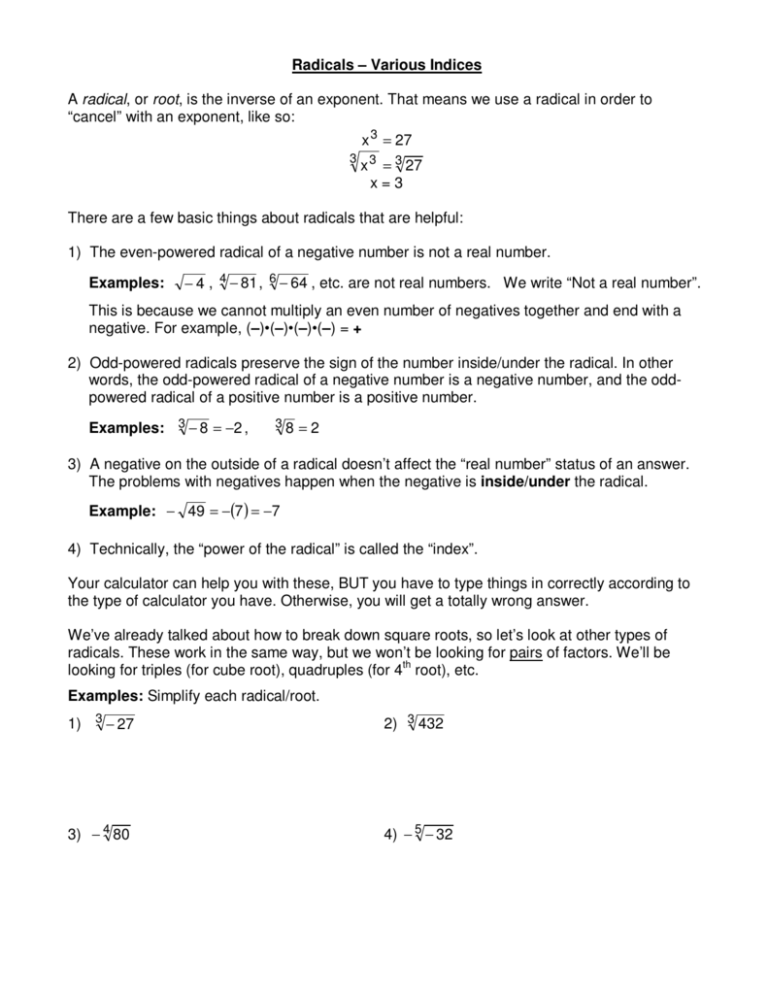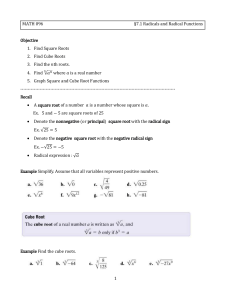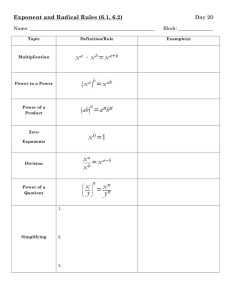Radicals – Various Indices A radical, or root, is the inverse of an
advertisement

Radicals – Various Indices A radical, or root, is the inverse of an exponent. That means we use a radical in order to “cancel” with an exponent, like so: x 3 = 27 3 3 x = 3 27 x=3 There are a few basic things about radicals that are helpful: 1) The even-powered radical of a negative number is not a real number. Examples: − 4 , 4 − 81 , 6 − 64 , etc. are not real numbers. We write “Not a real number”. This is because we cannot multiply an even number of negatives together and end with a negative. For example, (–)•(–)•(–)•(–) = + 2) Odd-powered radicals preserve the sign of the number inside/under the radical. In other words, the odd-powered radical of a negative number is a negative number, and the oddpowered radical of a positive number is a positive number. Examples: 3 − 8 = −2 , 38 =2 3) A negative on the outside of a radical doesn’t affect the “real number” status of an answer. The problems with negatives happen when the negative is inside/under the radical. Example: − 49 = −(7 ) = −7 4) Technically, the “power of the radical” is called the “index”. Your calculator can help you with these, BUT you have to type things in correctly according to the type of calculator you have. Otherwise, you will get a totally wrong answer. We’ve already talked about how to break down square roots, so let’s look at other types of radicals. These work in the same way, but we won’t be looking for pairs of factors. We’ll be looking for triples (for cube root), quadruples (for 4th root), etc. Examples: Simplify each radical/root. 1) 3 − 27 2) 3 432 3) − 4 80 4) − 5 − 32 When variables are involved, there’s one thing that we normally have to be careful about (the even-powered root thing). In order to bypass this issue, we’re going to assume all variables represent non-negative numbers. To simplify with variables, we’re going to go back to the basic definition of a radical (remember, we’re assuming variables aren’t negative numbers): a square root cancels out a square, a cube root cancels out a cube, a 4th root cancels out a 4 exponent, etc. Remember, the way to simplify radicals without using the factor tree depends on us breaking down our numbers into parts. For example: 50 = 25 • 2 = 25 • 2 5• 2 = We broke the 50 down into 25 • 2 because 25 is a square number and we want to take the square root. Using 10 • 5 wouldn’t help us because neither 10 nor 5 are square numbers. We’re going to do the same thing with variables, but it’s a little easier to see what’s going on when using variables than it is with regular numbers. Examples: Simplify each radical/root. x10 5) 6) 4 12 x 7) 3 x6 Compare your answers to your original problem to see if you can tell what the pattern is! x10 = ______ 4 12 x 3 = ______ x 6 = ______ Exponent is ______________________ Exponent is ______________________ Exponent is ______________________ So, in general, the pattern is this: root power x = ________________________ While it may look worse written that way, there are times when it’ll be easier to work with radicals that are written in this format. This takes us to… Rational Exponents A rational (or fractional) exponent is the combination of a power and a root. Normally, x2 is the 2 2 3 1 x . Notice that the denominator is “1”, so there’s no root. In something like x , the same as “2” still means the power that “x” is being raised to, but the “3” represents that we also have to take the cube root. Do you think it matters whether we take the root of x first or square the x first? 2 x3 3 = x2 Well, let’s try plugging in a value for x and see what happens! Let’s take the cube root first and then square the number: 2 3 8 38 2= ( ) 2 (_____ ) Now let’s square the number first and then take the cube root. 2 3 8 =_______ 3 2 8 = 3 ________ = _________ So, does it matter which we do first? __________ And, indeed, because they are inverses of each other, it’s not going to matter which we do first. It is, however, usually easier to take the root first because then we’re dealing with smaller numbers. Notice how the first way is easier to do in your head than the second way. Let’s practice a few of these. Remember what the negative exponent means! Examples: Simplify the following expressions. 1) 3 16 2 2) 1 2 25 − 3) 64 2 3 4) 5 − 83 Websites of Interest: http://www.purplemath.com/modules/exponent5.htm http://www.youtube.com/watch?v=wDn8IuAgRwc (This is kinda funny, actually) The good news is that the same laws of exponents that applied for integers back in Section 5.1 also work for this section. 1) When you’re multiplying like bases, you add exponents. 2) When you’re dividing like bases, you subtract exponents. 3) When you have a power raised to a power, you multiply the powers. 4) A negative exponent still means to put the base with the exponent in the opposite position in the fraction. (Top or bottom) Examples: Simplify the following expressions. 1) 2 x3 1 2) a 4 4 • x3 1 1 3 2 x y 4) x 5 3) −6 3 x5 1 x 10 2 x2y 4 3 5) x −5y3 Now, we are going to discuss what happens when we simplify numbers and variables in radical form as opposed to exponent form. 2 2 3 Remember: x means 3 x , so we can write and simplify radicals in this form as well as in exponent form. Like with polynomials, we can combine things that have the same root, because a root is nothing more than a fractional exponent. In multiplication, we can take two roots that have the same index and multiply the numbers that are underneath the radical. We can also break apart numbers under the radical. (We will be using this idea to help us simplify larger radicals.) Division works similarly. We can divide numbers under the same indexed radical, or we can break apart numbers under the radical and then divide, depending on what the situation calls for. Examples – Simplify. 1) 2• 3 2) 3• 6 3) 49 81 4) 48 3






